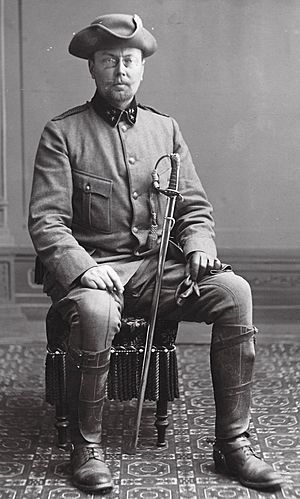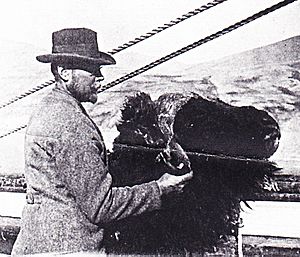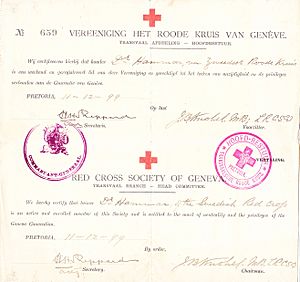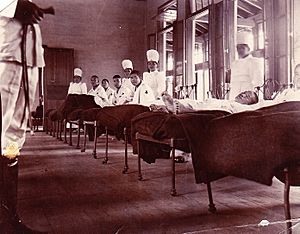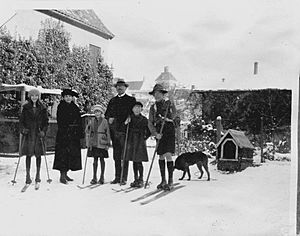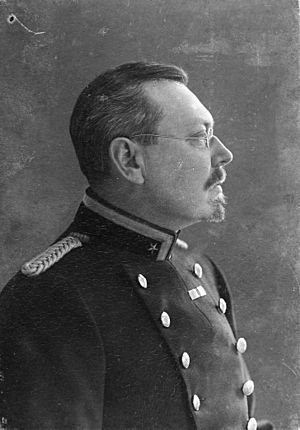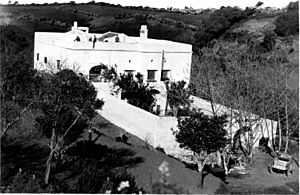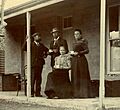Josef Hammar facts for kids
Josef Hammar (born November 15, 1868, in Helsingborg, Sweden – died August 4, 1927, in Bouzaréa, Algeria) was a Swedish doctor who worked with armies. He was also a great adventurer! Josef Hammar was a well-known doctor. He helped soldiers during the Second Boer War and the siege of Ladysmith. He also worked as a special observer for Sweden during the Russo-Japanese War and the siege of Port Arthur.
Contents
Josef Hammar's Life Story
Early Years and Education
Josef Hammar was born in Helsingborg, Sweden. His father, August Hammar, was a vicar. In 1886, Josef finished school in Helsingborg. He then went to Lund University to study.
In 1888, he earned a Medico-Philosophical degree. He continued his studies at the Karolinska Institute in 1889. Four years later, in 1893, he became a Candidate of Medicine. He kept studying and practicing medicine. In 1895, he worked as an assistant at a clinic in Lund. He also served as a medical scholar with different army groups. By September 1898, he became a certified doctor. His first job was in the Hammenhög district.
Searching for Andrée's Expedition
In the spring of 1899, Josef Hammar joined an expedition to Greenland. He went as the doctor for the group. The expedition was led by A. G. Nathorst. Their main goal was to search for Salomon August Andrée. Andrée had tried to reach the North Pole by hot air balloon two years earlier. Hammar had wanted to join Andrée's trip but wasn't accepted.
The ship, named Antarctic, left Stockholm on May 20, 1899. They sailed to Jan Mayen Island and then to Greenland. They explored the coast, collecting rocks and hunting animals. Hammar's special job was to find old Eskimo villages. He also collected items from their culture. About 278 items he found are now in the Museum of Ethnography, Sweden in Stockholm. The expedition returned to Stockholm on September 17, 1899.
Canoeing Fun
Josef Hammar was one of the first people in Sweden to enjoy canoeing and kayaking. He even took his canoe, named Kajaka, on the 1899 Greenland trip. Later, he joined Sweden's oldest canoe club, Föreningen för Kanot-Idrott.
Doctor in the Second Boer War
In late 1899, the Second Boer War began in South Africa. Hammar wanted to help. He received money from the Swedish government and the Swedish Red Cross. This allowed him to travel to South Africa as a doctor. He joined a Dutch medical team.
He arrived in Pretoria in December 1899. He met President Paul Krüger. The president was thankful for Sweden sending a doctor. Hammar was needed more with the government's medical teams. He went to the front lines at the siege of Ladysmith. There, he helped set up a large field hospital.
Hammar then became the doctor for a group of about 500 soldiers called the Utrecht Commando. They were near Ladysmith. His medical team had six white and eight black helpers. They used ox carts, mules, and horses to move around. As the fighting got worse, more soldiers were hurt. Hammar was even under artillery fire while helping a wounded soldier. He worked as a field surgeon in several big battles. These included attacks on Ladysmith and battles at Spioenkopf and Colenzo. The British finally broke the siege of Ladysmith.
After Ladysmith was freed, Hammar's group moved to the mountains. They were often under attack. Hammar was safe but very hungry. He was also sick with dysentery. His group became very small, so he asked for leave. He went back to Pretoria. He tried to get another medical team, but the war was moving fast. The British took Johannesburg, and the Boer soldiers fled. Hammar decided it was time to go home.
He rode across the entire Transvaal region. He arrived in Machadodorp after ten days of travel. President Krüger was living there in his train car. Hammar visited him one last time. From Machadodorp, Hammar took a train to Delagoa Bay. He had no money and only the clothes he was wearing. Some Norwegians he met helped him with money. On June 25, 1900, he reached Pietermaritzburg. He stayed with his brother August, who lived on the British side of the conflict.
Hammar had supported the Boers at first. But his experiences changed his mind. He saw that their army was not well-organized. He wrote that he was critical of their methods. However, he still felt sympathy for the Boer people.
Time Between Wars
After returning from South Africa, Hammar gave many talks about his experiences. He worked as an assistant doctor at a hospital in Stockholm. From 1901 to 1904, he was a battalion doctor in northern Sweden. He also worked as a doctor in other towns.
In 1903, he got money to study medical equipment in Holland. He also trained as a military doctor.
Observer in the Russo-Japanese War
The Russo-Japanese War started in February 1904. Hammar was sent as a special observer for Sweden. His job was to study how the Japanese army handled medical care. King Oscar II gave him money for the trip. He also made deals with newspapers to send reports from the war.
Hammar traveled across the Atlantic Ocean to America. He took a train across the United States to San Francisco. There, he met his cousin, who he hadn't seen in years. From San Francisco, he sailed to Yokohama, Japan. He arrived on July 11, 1904.
In Japan, Hammar met with important Japanese officials. He was given a secret book about how the Japanese army's medical care worked. He visited military hospitals in Tokyo. He studied different war injuries. On August 2, he went to Hiroshima. He visited the largest military hospital in Japan. It could hold 4,000 patients and was being expanded.
On August 5, 1904, Hammar went to the front lines at Port Arthur. He watched a big attack on Port Arthur from a mountain. The fighting was very intense, and many soldiers were hurt. Hammar stayed at the front for four months. He visited medical stations and hospitals. He lived with other foreign officers. Once, a Spanish officer was wounded. Hammar rode his horse into the fighting to rescue him. For this brave act, he later received a special Spanish award.
The siege of Port Arthur lasted until January 1905. Hammar left in December 1904. He went back to Hiroshima and then Tokyo. There were many wounded soldiers in hospitals across Japan. Hammar met the Emperor Meiji and the Empress. He was also given a special Japanese award.
Hammar left Japan in February 1905. He sailed to many different ports, including Shanghai, Hong Kong, and Singapore. He then went to Marseille, France. After a stop in Berlin, he returned home to Stockholm in April 1905.
Family Life
On his way home from Japan, Hammar visited friends in Marseille. There, he met Hulda Sylvander. They got married a year later, on August 8, 1906, in Marseille. Josef and Hulda had four children:
- Frank Hammar (born 1908, died 1974): He became a Master of Science. He managed a radio station in Ethiopia and later led a company in Sweden.
- Mireille Hammar (born 1909, died 1959): She married a Swedish actor.
- Gösta Hammar (born 1911, died 1978): He owned a coffee farm in Angola.
- Ulla Hammar (born 1912, died 1987): She married her cousin and moved to Marseille.
Back in Sweden
When Hammar returned to Sweden, he gave talks and wrote articles about his war experiences. He had unique knowledge about warfare. He worked as an assistant at the Swedish Army's healthcare agency. He also studied the health of children in public schools. In 1907, he became a Captain. He also represented Sweden at a conference on school hygiene in London.
In 1908, he was chosen to help reorganize the Swedish Field Doctor Corps. He also studied diseases like metabolic and heart conditions. In 1910, he became a member of the Royal Academy of Military Science. He continued to study medical topics in Germany and Austria.
In 1915-1916, he traveled with his family through Germany and Switzerland to Marseille. This was during World War I. He may have wanted to study war medicine, but it's not clear if he did. In 1916, Hammar became a Regiment Doctor in the Swedish Medicine Corps. He was later posted to a cavalry regiment in Ystad. He also worked as a city doctor in Ystad for a few years.
Last Adventure in Algeria
Hammar tried to settle down in Ystad. He bought a large house and grew fruits and vegetables. But he still felt a strong desire for adventure. He wrote that he felt like his life was "a frozen curse" because he couldn't explore.
In 1926, his military regiment was closed. This meant Hammar was free to try new things. He bought a fruit farm in Bouzarea, Algeria. His first year was tough, with hailstorms ruining his crops. He was determined to keep going. However, on August 8, 1927, he died from heart problems.
Awards and Recognitions
Josef Hammar received many awards for his work and bravery:
- Field Doctor Scholarships (1896, 1899)
- Member of The Swedish Military Doctors Association (1899)
- Member of The Swedish Medical Society (1899)
- Knight of The Order of the Sacred Treasure 4th class (Japan, 1905)
- Knight of The Royal Order of Vasa 1st class (Sweden, 1905)
- Japanese campaign and merit medals (from the Russo-Japanese War, 1906)
- Knight of the Spanish White Cross of Military Merit, 1st class (Spain, 1906)
- Member of The Royal Military Science Academy (1910)
Images for kids


